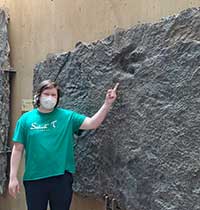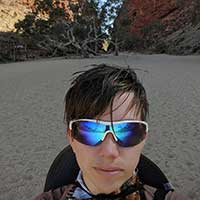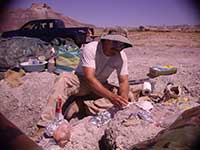 Devin K. Hoffman. Department of Geosciences, 4044 Derring Hall, Virginia Tech, Blacksburg, Virginia 24061, USA. devinkh5@vt.edu
Devin K. Hoffman. Department of Geosciences, 4044 Derring Hall, Virginia Tech, Blacksburg, Virginia 24061, USA. devinkh5@vt.edu
Devin Hoffman is a PhD candidate at Virginia Tech in the Department of Geosciences with the Paleobiology & Geobiology Research Group.
Devin's research interests include vertebrate responses to mass extinctions, diversification of archosaurs (crocodylians, birds, and their extinct relatives), and variation in evolutionary rates within and between archosaur clades. My current projects include reconstructing evolutionary rates of armored archosaurs, anatomical description of a new species of psuedosuchian archosaur, and describing an archosaur tooth assemblage from the Early Triassic of South Africa with South African colleagues at the Evolutionary Studies Institute.
Devin uses a variety of methods including computed tomography (CT), histology, and statistical methods to evaluate how these animals evolved in deep time and reconstruct the ecology of the communities through evolution.
Devin is also involved in science outreach. I regularly present at local and regional fossil fairs and science festivals. Most recently I participated with the Paleobiology Research Group at VT for the annual Virginia Tech Science Festival. I am currently collaborating with local high school science teachers to design anatomy teach kits and corresponding lesson plans for high school biology.
![]()
 Jess A. Miller-Camp, Department of Earth and Atmospheric Sciences, Indiana University, Bloomington, Indiana, USA. jessmc@iu.edu
Jess A. Miller-Camp, Department of Earth and Atmospheric Sciences, Indiana University, Bloomington, Indiana, USA. jessmc@iu.edu
Jess Miller-Camp (they/them) earned a B.S. in Geology with a minor in Biology (2007) from Appalachian State University in 2007, followed by an M.S. (2010) and Ph.D. (2016) in Geological Sciences from the University of Iowa. They were the Museum Scientist managing the University of California, Riverside Earth Sciences Museum from 2015–2018 before taking their current position as Collections Manager of the paleontology and zooarchaeology collections at Indiana University.
Miller-Camp's areas of research are: 1) How alligator evolution has been shaped by their environment, and 2) Lystrosaurus taxonomy and morphology. Their lines of inquiry include: phylogenetics, biogeography, morphometrics, paleoecology, and diversity dynamics. Other work has included museum advocacy, informally training students in museum studies, and science communication @DeadGators on Twitter, Instagram, and TikTok.
![]()
 Andrew B. Heckert, Department of Geological & Environmental Sciences, Appalachian State University, Boone, North Carolina, USA. heckertab@appstate.edu
Andrew B. Heckert, Department of Geological & Environmental Sciences, Appalachian State University, Boone, North Carolina, USA. heckertab@appstate.edu
Andrew Heckert earned a B.S. in Geology summa cum laude from Denison University in 1993 before earning an M.S. (1997) and Ph.D. (2001) from the Department of Earth & Planetary Sciences at the University of New Mexico. Subsequent to this he worked as the Geoscience Collections Manager at the New Mexico Museum of Natural History (2002-2005) before taking a post at Appalachian State University, where he is a professor in geology and director of the McKinney Geology Teaching Museum. Drs. Heckert and Viner first met as members of the Talawanda High School Marching Braves.
Heckert's research interests revolve around Late Triassic stratigraphic, biostratigraphic, and paleontologic issues, focusing primarily on microvertebrates, but he enjoys ranging up and down the section, and has collected vertebrates ranging in age from Devonian to Pleistocene from across North America. He continues to conduct field work across the American West and studies Triassic fossils from across Pangea.
Photo: A.B. Heckert working at the Krzyzanowski Bonebed in the Blue Hills of east-central Arizona, within a few miles, at most, of where the phytosaur described here was recovered. Photo by K. Cockerill.

